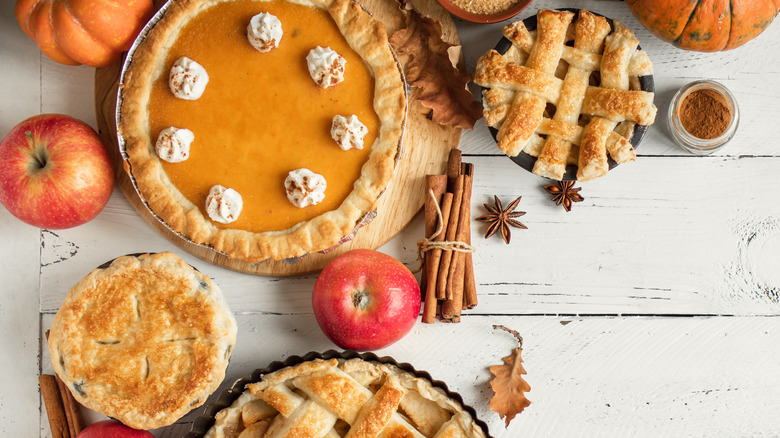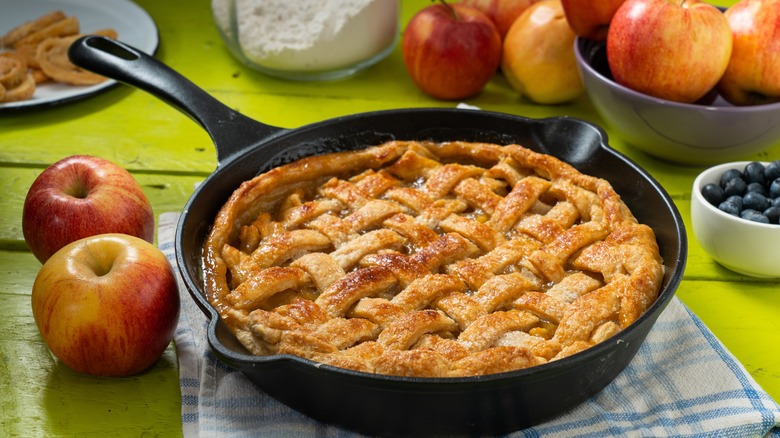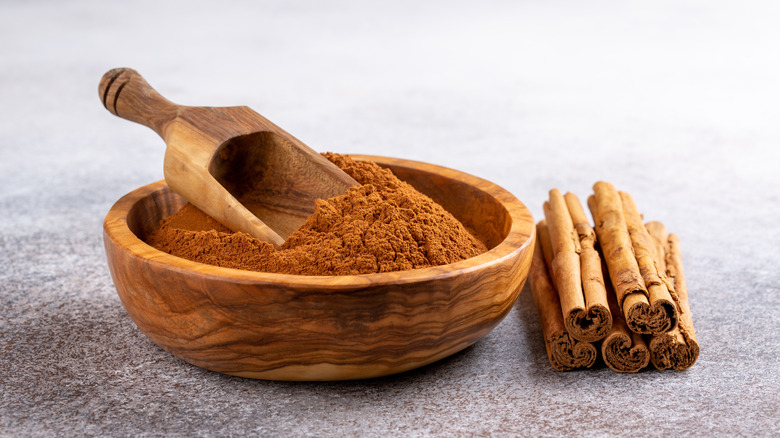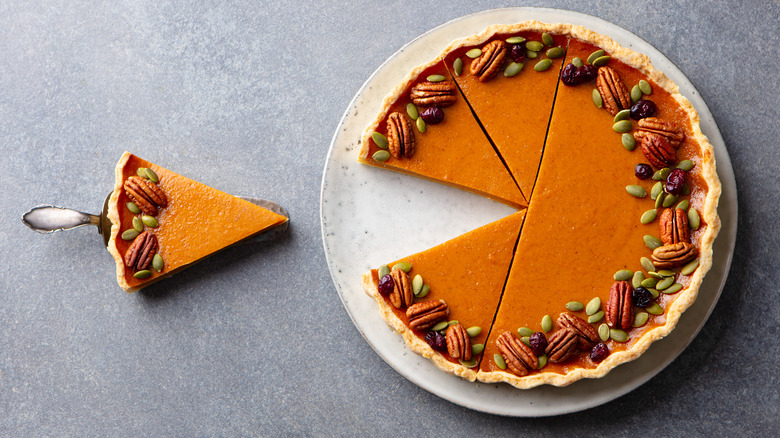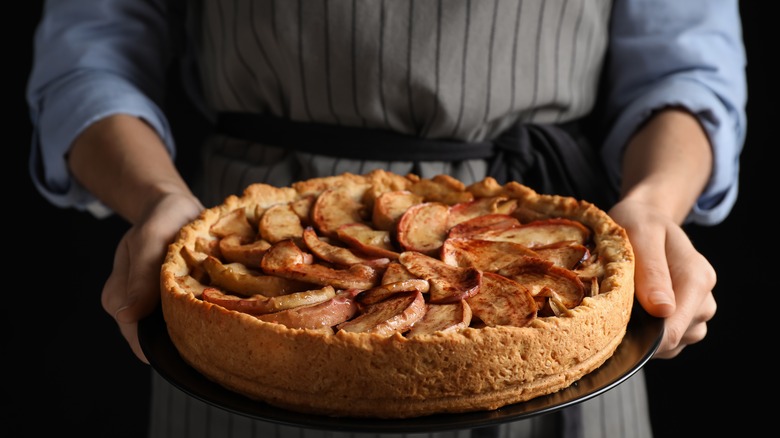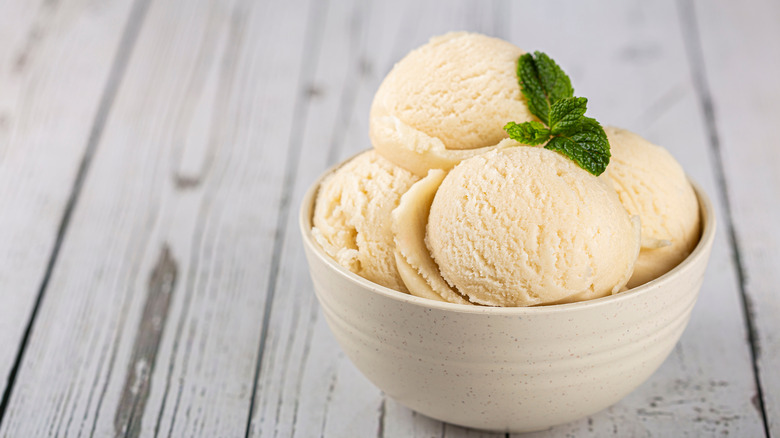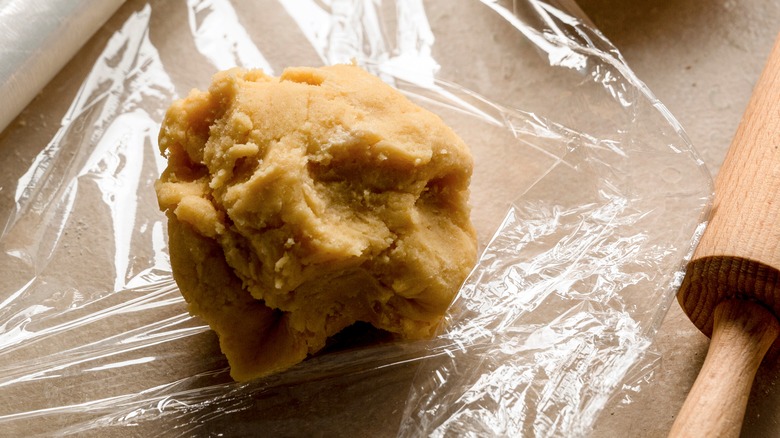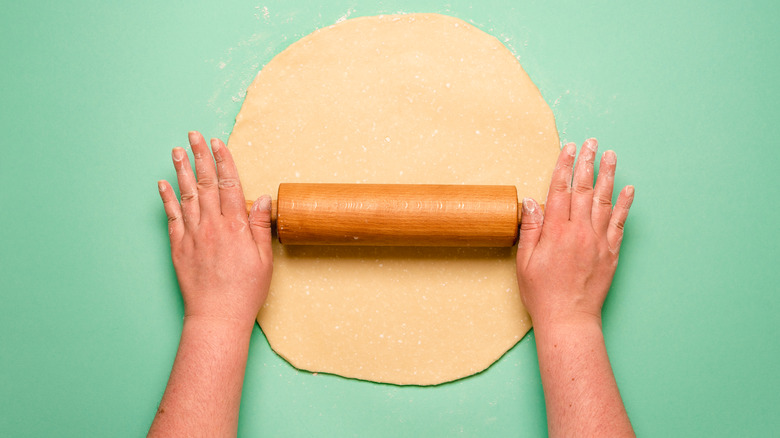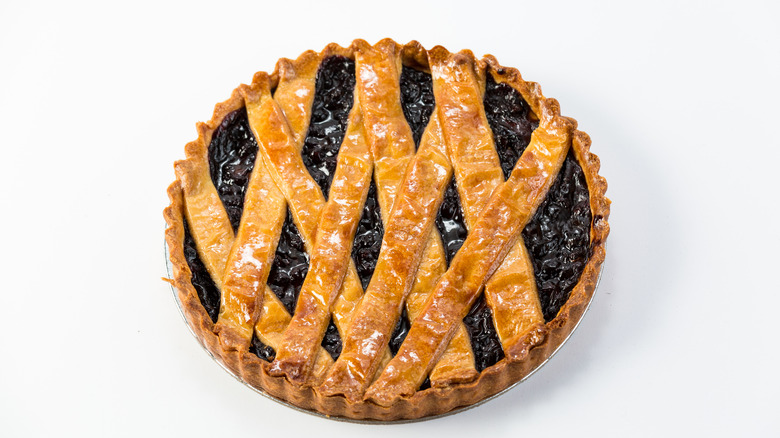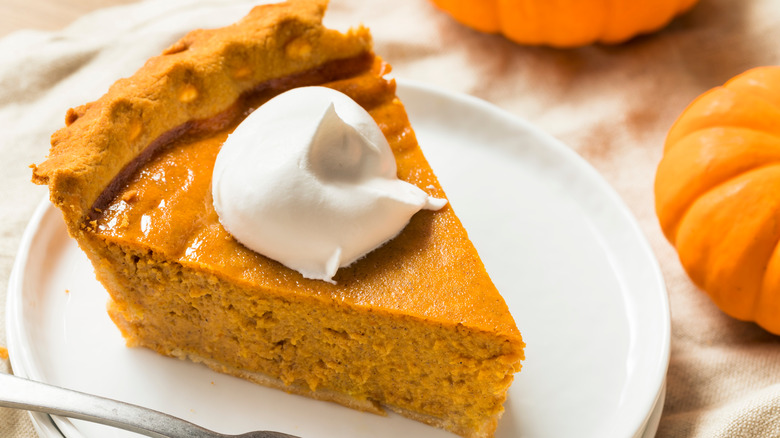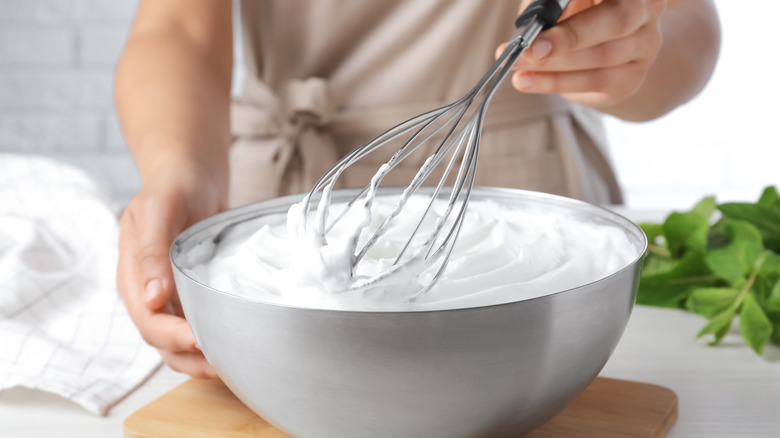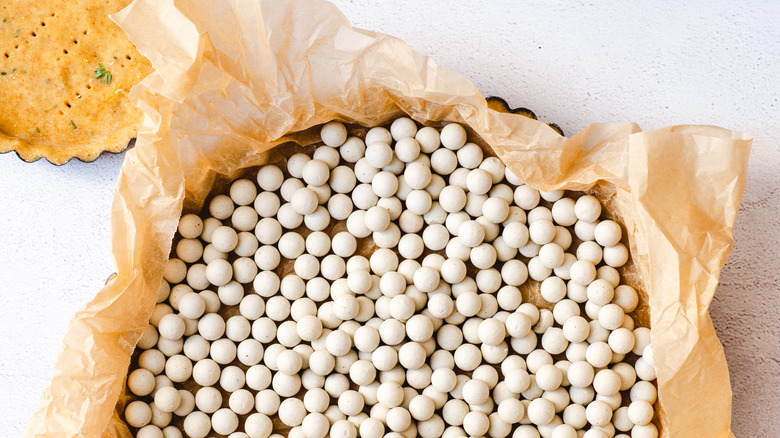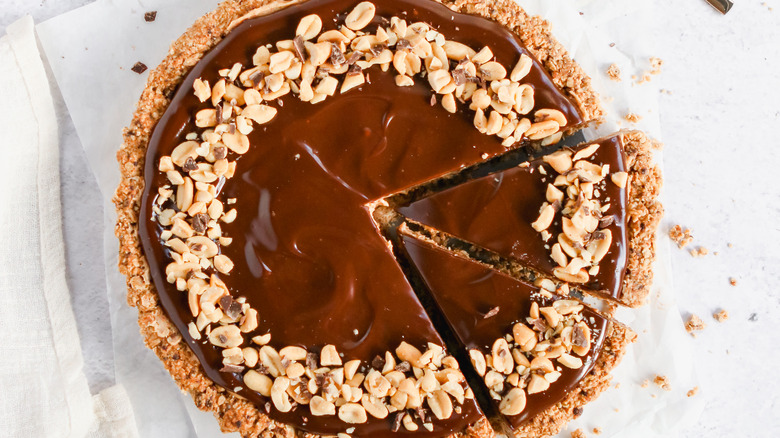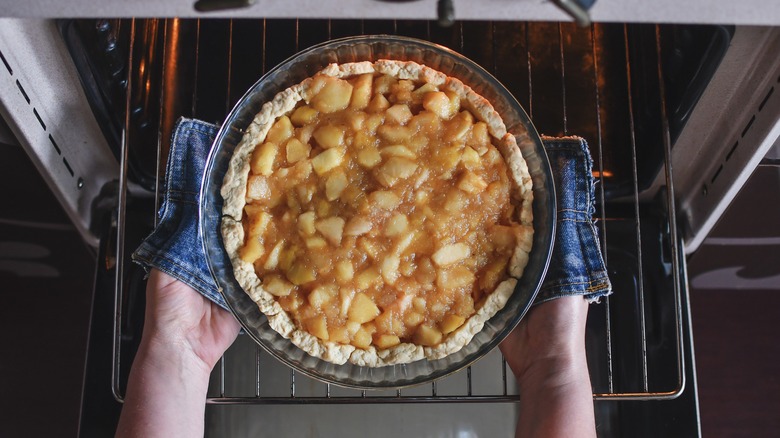14 Tips You Need When Baking Pie This Thanksgiving
There's no proper Thanksgiving dinner spread without pie. There are numerous types of Thanksgiving pies out there, including pecan, cream, and peanut butter. But these pie types are no match for the most popular options on Thanksgiving. The TODAY Show notes that in 2020, the most popular Thanksgiving pie in 14 states was the cranberry pie (although we've never heard of it), followed by sweet potato pie in 11 states. Real Simple notes that Thanksgiving triggers an over 300% increase in the popularity of pumpkin pie with apple pie following around at 240% (although, apple pie is popular for year-round baking).
If Thanksgiving is the only time of year you pick up a pie spatula, you should be prepared to step up your pie game this year. Here are some of our favorite tips to make better pies for your Thanksgiving table — no matter if you choose pecan over pumpkin.
Use a cast iron pan for a browner crust
The cast iron pan is a versatile addition to any home kitchen. But using a cast-iron skillet for your Thanksgiving pies may be the best decision you make all year. A cast-iron pan will ensure your crust is evenly browned because it retains and holds heat much better than a ceramic pie dish or metal pie tins. The distribution of heat on all sides of the crust will also reduce the moisture, thus making for a more flaky crust.
If you plan to bake your pie in cast iron, you won't need to change the pie recipe to fit a cast iron pan instead of a ceramic dish or metal pan. Per Field Company, you should cook the cast iron pie at low levels in the oven for the most golden and crisp crust. Most pies bake in cast iron from 375 F to 425 F.
Use Ceylon cinnamon for more pungent spice
Pumpkin pie and apple pie are both dependent on the sweetness of cinnamon for a delicious pie recipe. Cassia cinnamon is the most common general cinnamon you'll find in the grocery store. It's spicy, a little sweet, and has an underlying mild smell. If you want a more flavorful pie, you should instead consider using Ceylon cinnamon for all of your pie-baking needs. Ceylon cinnamon is aromatic, rich, and floral. The taste of Ceylon cinnamon is much sweeter than cassia cinnamon, which is why you should consider using it more often for pies.
You can find Ceylon cinnamon at some specialty grocery stores or online retailers. Regardless of if you want to stick with the status quo when it comes to cinnamon, you should always use ground cinnamon for baking — or take a microplane grater to your cinnamon stick to produce the same flavor result as ground cinnamon.
Invest in a pie scorer for even slicing
No one likes to get a tiny slice of pie on Thanksgiving. If you want perfectly even pie slices, you should consider purchasing a pie scorer. This kitchen utensil makes clear lines on a pie so that you can cut each slice with ease.
The only thing worse than a small slice of pie is a messy slice of pie. One tip you can use to reduce a messy pie slice is to start by making three scores in the pie. When you add a second slit for a third slice, you'll find the contents of the slice to be loose enough to pick both slices of the pie out. You can scoop a pie slice out with a pie spatula for a mess-free scooping experience. The easiest kinds of pies to slice and scoop are cool ones, so consider placing the pie in the fridge for 15 to 20 minutes before slicing.
Make hot water crusts for dense toppings
The most common type of pastry used for pie crusts is a short-crust pastry. Chunks of butter are brought into flour slowly with cold water until a pastry ball is formed. Although this method produces a flaky crust perfect for apple pie, the short-crust pastry is not the most robust type of pastry out there.
If you're working with particularly dense toppings, like a turkey pot pie with your Thanksgiving leftovers, you'll want to use a hot-water crust pastry instead. The hot-water crust pastry is made by combing fat and water. Then, the fat and the water mixture is added to flour and kneaded to ensure proper hydration throughout. The water helps pre-gelatinize the starches in the flour and creates a heartier dough more resistant to cracks and tears in the dough. Although the dough might not be as flavorful as a delicate shortcrust pastry, it is more robust and holds up better in the long run.
Marinade your apples in ice cream for the perfect apple pie filling
Apple pie isn't something you'd exactly describe as "creamy." But if you add ice cream to your apples, you'll find an unexpected and flavorful result. You'll need to use ½ cup of ice cream per 2 ½ pounds of apples. Add the melted ice cream along with lemon juice, cinnamon, and sugar for about an hour before you prepare the pie. The ice cream acts like the use of cream in Dutch apple pie recipes. Plus, you'll get a delicious undertone of vanilla in your apple pie from the vanilla ice cream.
Regardless if you are adding ice cream to your apple pie, you should add cornstarch to your pie to help soak up the juices. You'll need half as much cornstarch as you would use flour to thicken your marinade. To prepare a cornstarch slurry, add one tablespoon of cornstarch to two parts of water and shake vigorously in a jar. The slurry will bind to water molecules in the pie (and ice cream) and keep your pie from leaking while it bakes.
Cool your pie crust in an ice bath
If you're baking many different pies on Thanksgiving, you'll want to keep the dough on a retainer. If you make the crust in bulk, you should plan to refrigerate the crust to keep the fats solidified. You can put your pie dough in a sealable bag and place the bag in an ice bath. This flash-cooling method won't produce the same ice crystals as the freezer.
If you are dead set on using the freezer as a way to have your bulk pie crust ready to go on Thanksgiving, you need to keep the freezing time down to about 30 minutes. Keep the dough in a ball rather than rolling the pastry thinly. Plus, when the dough is frozen in a disc shape it will be easier to roll out when it's time to prepare your favorite Thanksgiving pie. You'll get the same flaky pastry as if you were to make the pie crust that day.
Be gentle with the rolling pin
Determining how thick to roll your pie crust on Thanksgiving can be difficult. The trick to rolling out perfectly even pie crust is to be especially gentle with the rolling pin. After your pie crust is double-cooled, it is ready to roll out on a floured piece of parchment paper. The parchment paper will prevent the paper from sticking to the counter.
When you start first rolling out the crust, avoid rolling one part of the pie crust more than others. This will develop the gluten in the rolled part of the crust — thus creating a more dense and less flaky pastry. We recommend the technique of rolling the dough from the center outwards before rotating the parchment. Use even pressure on all sides of the dough to ensure that not one side of the pastry is thicker than another. You may have to gently lift part of the dough and add additional flour to prevent the dough from sticking to the parchment.
Blend your flour for a smoother-tasting pie crust
The traditional pie dough recipe uses just all-purpose flour. But there are numerous types of flour you can use to craft the perfect pie crust at home. For a lighter crust, you should consider doing a 1-to-1 ratio of all-purpose flour to pastry flour. Pastry flour has a lower protein concentration than all-purpose flour, which will not develop the same level of strength. If you don't have any, you can consider adding granulated sugar instead of pastry flour for a more tender crust.
Another type of flour to consider adding to your pie crust is whole wheat. Since whole wheat flour contains fibrous bran, germ, and endosperm, you'll find pie crust with a blend of whole wheat and all-purpose flour to be very nutty and flavorful. You'll need to keep using all-purpose flour in this crust because the whole wheat flour does not have enough gluten to form a sturdy crust, so a blend between the two flours is recommended.
Skip the homemade pumpkin puree
Homemade is always better, right? Not when it comes to pumpkin puree. You can easily screw up your pumpkin pie by using homemade puree because it has significantly more moisture than canned pumpkin puree. The extra wetness in the puree can lead to a soggy crust or a loose filling that breaks apart when you cut it.
You should always keep pumpkin puree in your pantry — regardless if you are a fan of pumpkin pie or not. You can freeze small portions of pumpkin pie in individually-wrapped plastic wrap pieces for feeding to your dog or garnishing yogurt, mixing with whipped cream, or mixing it with pasta sauce for an autumnal flavor. Canned pumpkin is rich in vitamins A and K, and antioxidants, and can be used as a replacement for butter or eggs in some recipes. And above all, it's the secret to a flawless pumpkin pie on Thanksgiving.
DIY your own whipped cream garnish
Homemade whipped cream will always trump the canned version that has a distinct plastic undertone. You can use either heavy cream or whipping cream to make your own whipped cream at home. Beat the cream with either a hand mixer or a stand mixer with a whisk attachment until the whipping cream is fluffy and soft.
One of the best parts about making your own whipped cream at home is that you are able to add whatever flavor infusions and sweeteners you desire. Our favorite ingredient to add to homemade whipped cream is honey. Honey complements the flavor in numerous pies including apple, pumpkin, and even peanut butter. You can add a bit of vanilla extract and a pinch of sea salt to juxtapose the sweetness in the pie. Your guests will be ecstatic when they see the homemade touch of your whipped cream on Thanksgiving day.
Blind-bake your pie crust
Blind-baking, for pie novices, is essentially baking pre-baking the pie crust before adding fillings. There are several benefits to blind-baking the pie crust. In the case of custard pies, you should pre-bake the crust for a golden crust to avoid curling the inside of the pie. Blind-baking is also great for pies with a cold filling that still need a crunchy shell (like peanut butter pie).
To blind-bake a pie, you'll want to press the empty pie crust into a tin. Take a fork and stab the bottom of the crust a few times to prevent the crust from puffing up as it cooks. Then, add a parchment paper or aluminum foil layer to the pie, filled with either dried beans or pie weights. This will prevent the crust from rising and will cause it to keep the same shape as the pie tin. Blind-baking only lasts between 10 and 20 minutes; just don't forget to let your pie adequately cool before adding the rest of the fillings for the perfect pie.
Experiment with flavoring your pie crust
While a shortcrust pie crust is traditional, there are numerous possibilities to flavor your pie crust. You can add shortbread cookies to your food processor and mix the pulverized pie pieces into the pie crust. You'll get a delicious buttery flavor from the cookies as well as an opportunity to soak up leftover moisture in the crust. For an extra spicy kick, add some cinnamon, cloves, or nutmeg to your pie crust.
The other option for your pie crust is to add a scoop of cocoa powder to the crust. You'll need to substitute some of the flour for the cocoa powder to maintain the same moisture, as well as add a bit of sugar to contrast the bittersweet flavor of the powder. Cocoa powder pie crust is the perfect complement to a peanut butter pie, but it can also be used as an upgrade for pumpkin pie.
Make a vegan pie with a few substitutions
Thanksgiving should be for everyone — including the vegans. You can vegan-ize your pie recipe by substituting a few critical ingredients in the crust and the filling. Instead of butter, you'll want to substitute solid coconut oil or vegetable shortening. Although you still won't see the same buff as a butter crust (as butter contains more moisture than vegan substitutes), you will get a nice tender, flaky crust.
Most fruit pie fillings, such as apple and cherry, are vegan naturally. Cream pies, like banana cream or chocolate custard, can be more finicky to work with and vegan-ize. You can substitute coconut milk or almond milk for dairy-based creams, or go rogue and try a cream pie with silken tofu. Silken tofu is custardy when it is pureed, so it can act as a blank canvas for your favorite flavorings like cocoa powder, honey, or maple syrup.
You need to cool it adequately before slicing
One of the biggest mistakes people make with pies is not adequately cooling the pies before slicing and serving each pie. Pumpkin pie, for example, needs to sit undisturbed for at least half an hour (or up to two hours) before slicing and serving. This will allow the custard to finish cooking and set in the crust. Peanut butter pie, an unbaked dessert, needs to set for about three hours before serving in order to harden the peanut butter whipped cream into place.
If you're making pecan pie, you'll need to allocate a slightly larger cooling window than other pie types at around three hours. The golden syrup and butter mixture needs adequate time to set into the pie crust; this will prevent a wobbly pecan pie that oozes once sliced on the plate. If you want to heat the pecan pie (just so it melts the ice cream you top your pie with), cut a small slice and place the pie in the microwave.
